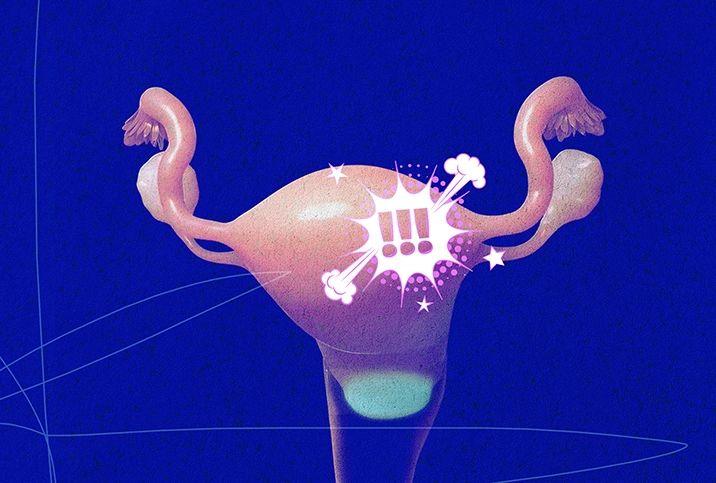But what does it mean if the pain persists or comes with other symptoms, such as nausea? Do you ever feel intense cramping after intercourse? You may be experiencing a bruised cervix.
What causes this issue?
"A bruised cervix can occur if there is inadequate lubrication or forceful penetration during sex," explained Jerome Chelliah, M.D., a board-certified OB-GYN at HerMD in Cleveland.
To be clear, this occurrence isn't exclusive to penis-in-vagina intercourse.
"If a penis, dildo, finger or other object reaches the cervix and hits it continuously, this deep penetration can cause the symptoms of a bruised cervix," said Heather Bartos, M.D., an OB-GYN in Texas. "It's unlikely to be anything else that causes it due to the anatomical location of the cervix."
However, a penis or toy are the most likely culprits. While fingering is a highly unlikely culprit, it's not totally impossible, said Lena Peak, M.S.W., a sexuality educator with @queersextherapy and the Expansive Group in Chicago. She explained fingers would have to penetrate deep enough and hard enough to lead to bruising. Chelliah also warned against long or freshly cut fingernails which could be sharp.
Will this happen to you? The good and bad news
Peak said the chance of getting a bruised cervix depends on three factors: sex position, vaginal canal length and where someone is in their cycle.
For example, while deep penetration feels incredible for some people, it can increase the likelihood of bruising. We see this with positions such as doggy style and flatiron, according to Peak.
As far as your vagina's length, well…there's not much you can do about that.
"Vaginal canal lengths vary from person to person, and people with shorter vaginal canals may be at an increased likeliness for a bruised cervix after penetrative sex," Peak said.
Other than rough sex and not enough lubrication, factors that could up your chances include: cervical ectropion, which has signs including discharge that may contain blood or mucus, bleeding or pain after sex, spotting and pelvis pain; ovulation, which occurs 14 days before your next period; and infections or cervicitis, which have similar symptoms as cervical ectropion, according to Chelliah.
"Cervical bruising is more likely to occur during ovulation when the cervix is softer, more open and tilted downward," Peak explained.
Look for these signs
Chelliah said the most common presentation of cervical bruising is spotting between periods, though you may experience uterine cramps, nausea and vomiting, too.
According to Peak, the most common sign is pain during or after penetration. The pain can be sharp and acute or dull and achy.
"The pain is typically felt internally and/or via abdominal cramping and back pain," she said.
You and your doctor won't be able to physically see the bruise because, while this complication is real, it doesn't look like a bruise usually does on the rest of the body.
"Note the word 'bruised' here refers to the pain, not how the cervix actually looks," Bartos said. "It almost feels like how men describe getting kicked in the testicles, which makes sense."
Your symptoms should last anywhere from a few days to a week, the experts said, and typically won't entail any permanent issues.
Treatment
If you're experiencing symptoms, you don't necessarily need to visit a doctor. To some degree, you just have to wait it out and implement at-home treatment options.
Chelliah encouraged pelvic rest and taking NSAIDs, such as ibuprofen. Bartos said the same thing, mentioning a heating pad and sitting on a cushion, too.
If these measures don't help, especially after the specified time frame, you probably need to see a doctor.
"If you're still experiencing pain after a week or if you're experiencing frequent, recurring cervical bruising, you may want to consider speaking to a gynecologist and/or pelvic floor therapist," Peak said.
How to avoid bruising your cervix next time
After experiencing pain and sickness, you may (understandably) feel nervous about bruising your cervix the next time you hit the sheets. But we have good news: There are precautions you can take.
First and foremost, Peak said, make sure you're plenty aroused (read: wet and turned on) before any penetration happens.
"The cervix gets softer and moves to a higher position during arousal, which can prevent or decrease the likeliness of cervical bruising," she explained.
If you don't get super-wet on your own, no shame there—just grab a bottle of lube.
Additionally, ensure communication, comfort and respect are top of mind for you and your partner(s). If you're experiencing pain or discomfort, let them know.
"You might want to ask for less deep [or] forceful penetration, to switch to a position where you have more control over the depth [or] force of penetration, [for example,] cowperson [or] being 'on top,' to establish a safe word or safe gesture that indicates stopping, pausing, slowing down, or to take a break from penetration to explore nonpenetrative erotic activities and erogenous zones," Peak suggested.
Remember: A bruised cervix can cause terrible pain and nausea after sex, but you're not doomed to experience it forever. Finding the right position and making sure you're turned on and lubricated are keys to prevention.
